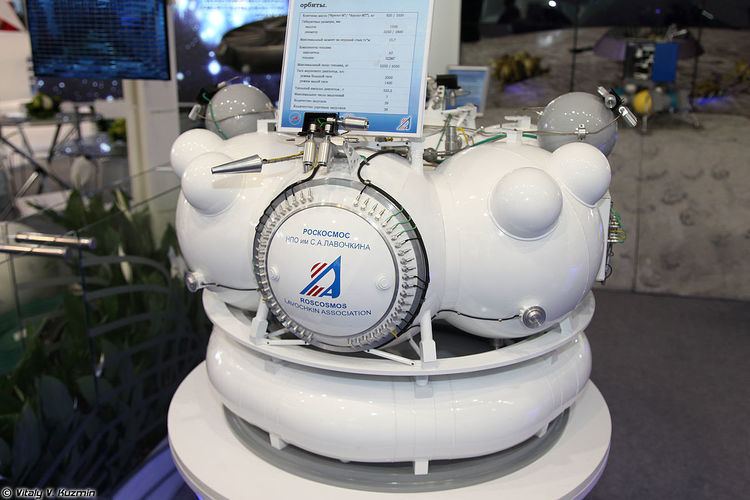Manufacturer NPO Lavochkin Used on Soyuz, Zenit-3F | Country of origin Russia Length 1.5 m (4.9 ft) | |
 | ||
Diameter Fregat/Fregat-M: 3.35 m (11.0 ft)
Fregat-MT: 3.80 m (12.5 ft) Propellant mass Fregat: 5,250 kg (11,570 lb)
Fregat-M: 5,600 kg (12,300 lb)
Fregat-MT: 7,100 kg (15,700 lb) | ||
Fregat (Russian: Фрегат, frigate) is an upper stage developed by NPO Lavochkin in the 1990s, which is used in some Soyuz and Zenit rockets. Its liquid propellant engine uses UDMH and N2O4.
Contents
Description
Fregat upper stage is designed for injecting large payloads into a low, medium-height or high geosynchronous orbit. Fregat is a versatile upper stage, in addition to orbital insertion, it can be used as an escape stage to send modern space probes into interplanetary trajectories (e.g. Venus Express and Mars Express). Fregat stages are currently used as the fourth stage of some Soyuz launch vehicles. The stage can be restarted up to 25 times,
NPO Lavochkin has built many interplanetary probes, and the Fregat stage follows their design traditions. The main part of the stage is six intersecting spheres placed on a single plane, four of which contain propellants. The remaining two contain the control equipment. The main engine is placed between the spheres, so Fregat is a tightly-packed stage with a diameter much larger than its height.
August 2014 failure
The Arianespace-operated flight of a Fregat MT ended in failure on 22 August 2014 after the vehicle deposited two EU/ESA Galileo navigation satellites into the wrong orbit. The lift off at 1227 GMT from the Sinnamary launch site near Kourou, French Guiana, appeared to go well. However, a failure was only apparent later when, after the second firing of the Fregat MT upper stage had taken place, the satellites were detected as being in the wrong orbit.
The Independent Inquiry Board formed to analyze the causes of the "anomaly" announced its definitive conclusions on October 7, 2014 following a meeting at Arianespace headquarters in Évry, near Paris.
The failure occurred during the flight of the Fregat fourth stage. It occurred about 35 minutes after liftoff, at the beginning of the ballistic phase preceding the second ignition of this stage.
The scenario that led to an error in the orbital injection of the satellites was precisely reconstructed, as follows:
The root cause of the failure of flight VS09 is therefore a shortcoming in the system thermal analysis performed during stage design, and not an operator error during stage assembly.
Since August 22, 2014 Soyuz ST-B launch vehicles with Fregat-MT upper stages have performed three successful launches, six Galileo (satellite navigation) navigation satellites have been inserted into their target orbits in frame of Soyuz at the Guiana Space Centre ongoing ESA programme.
Fregat-M/Fregat-MT
Fregat-M/Fregat-MT tanks have ball-shaped additions on the tops of the tanks. These additions increase the load capability of the propellant from 5,350 kilograms (11,790 lb) to 6,640 kilograms (14,640 lb), without causing any other changes to the physical dimensions of the vehicle.
Fregat-SB
A version called Fregat-SB can be used with Zenit-2SB rocket. This version is a variation of Fregat-M with a block of drop-off tanks ("SBB" or Сбрасываемый Блок Баков in Russian) which makes increased payload capability possible. The torus-shaped SBB weighs 360 kilograms (790 lb) and contains up to 3,050 kilograms (6,720 lb) of propellant. The total dry weight of the Fregat-SB (including SBB) is 1,410 kilograms (3,110 lb) and the maximum propellant carrying capacity is 10,150 kilograms (22,380 lb).
Fregat-SB was launched for the first time on 20 January 2011, when it lifted the Elektro-L weather satellite into geosynchronous orbit.
